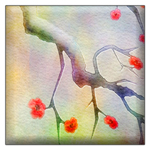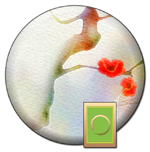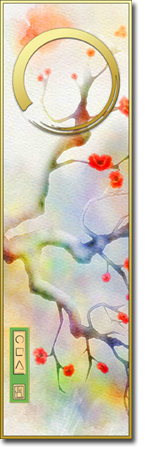On The Way: The Daily Zen Journal
Mind is Formless
Huang-Po (d. 850)
You people seek to measure all within the void, foot by foot and inch by inch; I repeat to you that all phenomena are devoid of distinctions of form. Intrinsically they belong to that perfect tranquility which lies beyond the transitory sphere of form-producing activities, so all of them are co-existent with space and one with reality.

Since no bodies possess real form, we speak of phenomena as void; and, since Mind is formless we speak of the nature of all things as void. Moreover, none of the numerous doctrines has any existence outside your original Mind. All this talk of Bodhi, Nirvana, the Absolute, the Buddha-Nature, Mahayana, Theravada, Bodhisattvas and so on is like taking autumn leaves for gold.
To use the symbol of the closed fist: when it is opened, all beings—both gods and people—will perceive there is not a single thing inside. Therefore it is written:
“There’s never been a single thing;
Then where’s defiling dust to cling?”
If “there’s never been a single thing,” past, present, and future are meaningless. So those who seek the Way must enter it with the suddenness of a sword-thrust. Full understanding of this must come before they can enter.
Hence, though Bodhidharma traversed many countries on his way from India to China, he encountered only one man, the Venerable Ko, to whom he could silently transmit the Mind-Seal, the Seal of your own real Mind.
Phenomena are the Seal of the Mind, just as the latter is the Seal of phenomena. Whatever Mind is, so also are phenomena—both are equally real and partake equally of the Dharma-Nature, which hangs in the void.

One who receives an intuition of this truth has become a Buddha and attained to the Dharma. Let me repeat that Enlightenment cannot be bodily grasped, for the body is formless; nor mentally grasped, for the mind is formless; nor grasped through its essential nature since that nature is the Original Source of all things, the real Nature of all things, permanent Reality, of Buddha!
How can you use the Buddha to grasp the Buddha, formlessness to grasp formlessness, mind to grasp mind, void to grasp void, the Way to grasp the Way? In reality there is nothing to be grasped—even not-grasping cannot be grasped. So it is said: “There is Nothing to be grasped.” We simply teach you how to understand your original Mind.
Moreover, when the moment of understanding comes, do not think in terms of understanding, not understanding or not not-understanding, for none of these is something to be grasped. This Dharma of Thusness when ‘grasped’ is ‘grasped,’ but one who ‘grasps’ it is no more conscious of having done so than someone ignorant of it is conscious of his failure.

Ah, this Dharma of Thusness—until now so few people have come to understand that it is written: “In this world, how few are they who lose their egos!” As for those people who seek to grasp it through the application of some particular principle or by creating a special environment, or through some scripture, or doctrine, or age, or time, or name, or word, or through their six senses—how do they differ from wooden dolls?
But if, unexpectedly, one person were to appear, one who formed no concept based on any name or form, I assure you that this person might be sought through world after world, always in vain! Their uniqueness would assure them of succeeding to the Patriarch’s place and earn for them the name of Shakyamuni’s true spiritual descendant: the conflicting aggregates of the ego-self would have vanished, and they would indeed be that One!

Therefore it is written: When the King attains to Buddhahood, the princes accordingly leave their home to become monks. Hard is the meaning of this saying! It is to teach you to refrain from seeking Buddhahood, since any search is doomed to failure.
Huang Po (d. 850)
excerpted from The Zen Teaching of Huang Po – On the Transmission of Mind trans by John Blofeld





As beginners, to find our centered posture in sitting meditation we move side to side slowly and then back and forth, naturally coming to know our center. With practice, those movements are dropped, and we are familiar with the centered posture. It is a technique we use at first and then can discard.
Similarly to enter a life of flow or become one with the Way, in the beginning, there are numerous teachings and techniques to give us a starting point. If we have a good teacher, we are made aware that these are expedients and know not to get attached to any of them.
However, we do need a place to start as most of us can’t jump from our conditioned views to the experience of no ego. And in reality “In this world, how few are they who lose their egos!”
Huang Po is speaking of a very advanced level of practice – our goal-less goal, but we still need a way to get there. Recall the Sixth Patriarch’s poem written on the monastery wall in response to Shen-hsiu’s enlightenment poem:
“The body is a bodhi tree
the mind is like a standing mirror
always try to keep it clean
don’t let it gather any dust.”
Shen-hsiu
“Bodhi is essentially not like a tree,
Nor is it like a bright mirror.
Originally not one thing exists
So where can dust alight?”
Hui-neng
Both of these gathas have their place in practice; they are written from a different perspective in practice. There is a place for all levels of understanding and a need for the expedients that help us drop views at some point.
On the Way together,
Elana, Scribe for Daily Zen